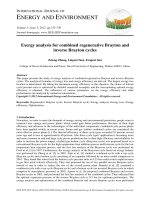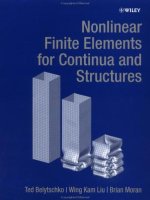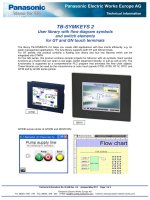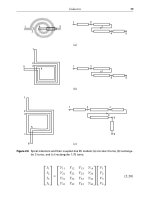- Trang chủ >>
- Khoa Học Tự Nhiên >>
- Vật lý
Elements for physics quantities, qualities and intrinsic theories a tarantola
Bạn đang xem bản rút gọn của tài liệu. Xem và tải ngay bản đầy đủ của tài liệu tại đây (3.22 MB, 280 trang )
%JFTFS'BSCBVTESVDLQEGGJMFLBOOOVSBOOÊIFSOE
EBTFOEHàMUJHF%SVDLFSHFCOJTXJFEFSHFCFO
),4 ),4
EFTJHOBOEQSPEVDUJPO(NC)n"ENDER
"MCFSU5BSBOUPMB
&MFNFOUT
GPS1IZTJDT
2VBOUJUJFT2VBMJUJFT
BOE*OUSJOTJD5IFPSJFT
ISBN 3-540-25302-5
l
TQSJOHFSPOMJOFDPN
8IJMFVTVBMQSFTFOUBUJPOTPGQIZTJDBMUIFPSJFT
FNQIBTJ[FUIFOPUJPOPGQIZTJDBMRVBOUJUZUIJTCPPL
TIPXTUIBUUIFSFJTNVDIUPHBJOXIFOJOUSPEVDJOH
UIFOPUJPOPGQIZTJDBMRVBMJUZ5IFVTVBMQIZTJDBM
RVBOUJUJFTTJNQMZBQQFBSBTDPPSEJOBUFTPWFSUIF
NBOJGPMETSFQSFTFOUJOHUIFQIZTJDBMRVBMJUJFT
5IJTBMMPXTUPEFWFMPQQIZTJDBMUIFPSJFTUIBUIBWF
BEFHSFFPGJOWBSJBODFNVDIEFFQFSUIBOUIFVTVBM
POF*UJTTIPXOUIBUQSPQFSMZEFWFMPQFEQIZTJDBM
UIFPSJFTDPOUBJOMPHBSJUINTBOEFYQPOFOUJBMTPG
UFOTPSTUIFJSDPOTQJDVPVTBCTFODFJOVTVBMUIFPSJFT
TVHHFTUTJOGBDUUIBUUIFGVOEBNFOUBMJOWBSJBODF
QSJODJQMFTUBUFEJOUIJTCPPLJTMBDLJOHJOQSFTFOUEBZ
NBUIFNBUJDBMQIZTJDT5IFCPPLSFWJFXTBOEFYUFOET
UIFUIFPSZJG-JFHSPVQTEFWFMPQTEJGGFSFOUJBMHFP
NFUSZQSPQPTJOHDPNQBDUEFGJOJUJPOTPGUPSTJPOBOE
PGDVSWBUVSFBOEBEBQUTUIFVTVBMOPUJPOPGMJOFBS
UBOHFOUBQQMJDBUJPOUPUIFJOUSJOTJDQPJOUPGWJFX
QSPQPTFEGPSQIZTJDT"TBOJMMVTUSBUJPOUXPTJNQMF
UIFPSJFTBSFTUVEJFEXJUITPNFEFUBJMUIFUIFPSZ
PGIFBUDPOEVDUJPOBOEUIFUIFPSZPGMJOFBSFMBTUJD
NFEJB5IFFRVBUJPOTGPVOEEJGGFSRVBOUJUBUJWFMZ
BOERVBMJUBUJWFMZGSPNUIPTFVTVBMMZQSFTFOUFE
5BSBOUPMB
&MFNFOUTGPS1IZTJDT
.
Elements for Physics
.
A. Tarantola
Elements for Physics
Quantities, Qualities, and Intrinsic Theories
With 44 Figures (10 in colour)
123
Professor Albert Tarantola
Institut de Physique du Globe de Paris
4, place Jussieu
75252 Paris Cedex 05
France E-mail:
LibraryofCongressControlNumber:
ISBN-10 3-540-25302-5 Springer Berlin Heidelberg New York
ISBN-13 978-3-540-25302-0 Springer Berlin Heidelb erg New York
This work is subject to copyright. All rights are reserved, whether the whole or part of the material
is concerned, specifically the rights of translation, repr inting, reuse of illustrations, recitation, broad-
casting, reproduction on microfilm or in any other way, and storage in data banks. Duplication of
this publication or parts thereof is permitted only under the provisions of the German Copyright Law
of September 9, 1965, in its current version, and permission for use must always be obtained from
Springer. Violations are liable to prosecution under the German Copyright Law.
Springer is a part of Springer Science+Business Media.
springeronline.com
© Springer-Verlag Berlin Heidelberg 2006
Printed in Germany
The use of general descriptive names, registered names, trademarks, etc. in this publication does not
imply, even in the absence of a specific statement, that such names are exempt from the relevant pro-
tective laws and regulations and therefore free for general use.
Typesetting: Data prepared by the Author using a Springer T
E
X macro package
Cover design: design & production GmbH, Heidelberg
Printed on acid-free paper SPIN 11406990 57/3141/SPI 543210
To Maria
Preface
Physics is very successful in describing the world: its predictions are often
impressively accurate. But to achieve this, physics limits terribly its scope.
Excluding from its domain of study large parts of biology, psychology, eco-
nomics or geology, physics has concentrated on quantities, i.e., on notions
amenable to accurate measurement.
The meaning of the term physical ‘quantity’ is generally well understood
(everyone understands what it is meant by “the frequency of a periodic
phenomenon”, or “the resistance of an electric wire”). It is clear that be-
hind a set of quantities like temperature − inverse temperature −logarithmic
temperature, there is a qualitative notion: the ‘cold−hot’ quality. Over this
one-dimensional quality space, we may choose different ‘coordinates’: the
temperature, the inverse temperature, etc. Other quality spaces are mul-
tidimensional. For instance, to represent the properties of an ideal elastic
medium we need 21 coefficients, that can be the 21 components of the elastic
stiffness tensor c
ijk
, or the 21 components of the elastic compliance tensor
(inverse of the stiffness tensor), or the proper elements (six eigenvalues and
15 angles) of any of the two tensors, etc. Again, we are selecting coordinates
over a 21-dimensional quality space. On this space, each point represents a
particular elastic medium.
So far, the consideration is trivial. What is important is that it is always
possible to define the distance between two points of any quality space, and this
distance is —inside a given theoretical context— uniquely defined. For instance,
two periodicphenomena can becharacterized bytheir periods, T
1
and T
2
, or
by their frequencies, ν
1
and ν
2
. The only definition of distance that respects
some clearly defined invariances is D = | log (T
2
/T
1
) | = | log (ν
2
/ν
1
) |.
For many vector and tensor spaces, the distance is that associated with
the ordinary norm (of a vector or a tensor), but some important spaces have
a more complex structure. For instance, ‘positive tensors’ (like the electric
permittivity or the elastic stiffness) are not, in fact, elements of a linear space,
but oriented geodesic segments of a curved space. The notion of geotensor
(“geodesic tensor”) is developed in chapter 1 to handle these objects, that
are like tensors but that do not belong to a linear space.
The first implications of these notions are of mathematical nature, and a
point of view is proposed for understanding Lie groups as metric manifolds
VIII Preface
with curvature and torsion. On these manifolds, a sum of geodesic segments
can be introduced that has the very properties of the group. For instance, in
the manifold representing the group of rotations, a ‘rotation vector’ is not
a vector, but a geodesic segment of the manifold, and the composition of
rotations is nothing but the geometric sum of these segments.
More fundamental are the implications in physics. As soon as we accept
that behind the usual physical quantities there are quality spaces, that usual
quantities are only special ‘coordinates’ over these quality spaces, and that
there is a metric in each space, the following question arises: Can we do
physics intrinsically, i.e., can we develop physics using directly the notion of
physical quality, and of metric, and withoutusing particular coordinates (i.e.,
without any particular choice of physical quantities)? For instance, Hooke’s
law σ
ij
= c
ij
k
ε
k
is written using three quantities, stress, stiffness, and strain.
But why not using the exponential of the strain, or the inverse of the stiffness?
One of the major theses of this book is that physics can, and must, be devel-
oped independently of any particular choice of coordinates over the quality
spaces, i.e., independently of any particular choice of physical quantities to
represent the measurable physical qualities.
Most current physical theories, can be translated so that they are ex-
pressed using an intrinsic language. Other theories (like the theory of linear
elasticity, or Fourier’s theory of heat conduction) cannot be written intrinsi-
cally. I claim that these theories are inconsistent, and I propose their refor-
mulation.
Mathematical physics strongly relies on the notion of derivative (or, more
generally, on the notion of tangent linear mapping). When taking into ac-
count the geometry of the quality spaces, another notion appears, that of
declinative. Theories involving nonflat manifolds (like the theories involv-
ing Lie group manifolds) are to be expressed in terms of declinatives, not
derivatives. This notion is explored in chapter 2.
Chapter 3 is devoted to the analysis of some spaces of physical qualities,
and attempts a classification of the more common types of physical quantities
used on these spaces. Finally, chapter 4 gives the definition of an intrinsic
physical theory and shows, with two examples, how these intrinsic theories
are built.
Many of the ideas presented in this book crystallized during discussions
with my colleagues and students. My friend Bartolom
´
e Coll deserves special
mention. His understanding of mathematical structures is very deep. His
logical rigor and his friendship have made our many discussions both a
pleasure and a source of inspiration. Some of the terms used in this book
have been invented during our discussions over a cup of coffee at Caf
´
e
Beaubourg, in Paris. Special thanks go to my professor Georges Jobert, who
introduced me to the field of inverse problems, with dedication and rigor.
He has contributed to this text with some intricate demonstrations. Another
friend, Klaus Mosegaard, has been of great help, since the time we developed
Preface IX
together Monte Carlo methods for the resolution of inverse problems. With
probability one, he defeats me in chess playing and mathematical problem
solving. Discussions with Peter Basser, Jo
˜
ao Cardoso, Guillaume Evrard,
Jean Garrigues, Jos
´
e-Maria Pozo, John Scales, Loring Tu, Bernard Valette,
Peiliang Xu, and Enrique Zamora have helped shape some of the notions
presented in this book.
Paris, August 2005 Albert Tarantola
Contents
0 Overview . . . . . . . . . . . . . . . . . . . . . . . . . . . . . . . . . . . . . . . . . . . . . . . . . . . . . 1
1 Geotensors . . . . . . . . . . . . . . . . . . . . . . . . . . . . . . . . . . . . . . . . . . . . . . . . . . . 11
1.1 Linear Space. . . . . . . . . . . . . . . . . . . . . . . . . . . . . . . . . . . . . . . . . . . . . . 11
1.2 Autovector Space . . . . . . . . . . . . . . . . . . . . . . . . . . . . . . . . . . . . . . . . . 18
1.3 Oriented Autoparallel Segments on a Manifold . . . . . . . . . . . . . 31
1.4 Lie Group Manifolds . . . . . . . . . . . . . . . . . . . . . . . . . . . . . . . . . . . . . . 41
1.5 Geotensors . . . . . . . . . . . . . . . . . . . . . . . . . . . . . . . . . . . . . . . . . . . . . . . 75
2 Tangent Autoparallel Mappings . . . . . . . . . . . . . . . . . . . . . . . . . . . . . . . 79
2.1 Declinative (Autovector Spaces) . . . . . . . . . . . . . . . . . . . . . . . . . . . 81
2.2 Declinative (Connection Manifolds) . . . . . . . . . . . . . . . . . . . . . . . . 87
2.3 Example: Mappings from Linear Spaces into Lie Groups . . . . . 92
2.4 Example: Mappings Between Lie Groups . . . . . . . . . . . . . . . . . . . 100
2.5 Covariant Declinative . . . . . . . . . . . . . . . . . . . . . . . . . . . . . . . . . . . . . 102
3 Quantities and Measurable Qualities . . . . . . . . . . . . . . . . . . . . . . . . . . 105
3.1 One-dimensional Quality Spaces . . . . . . . . . . . . . . . . . . . . . . . . . . . 107
3.2 Space-Time . . . . . . . . . . . . . . . . . . . . . . . . . . . . . . . . . . . . . . . . . . . . . . . 118
3.3 Vectors and Tensors . . . . . . . . . . . . . . . . . . . . . . . . . . . . . . . . . . . . . . . 122
4 Intrinsic Physical Theories . . . . . . . . . . . . . . . . . . . . . . . . . . . . . . . . . . . . 125
4.1 Intrinsic Laws in Physics . . . . . . . . . . . . . . . . . . . . . . . . . . . . . . . . . . 125
4.2 Example: Law of Heat Conduction . . . . . . . . . . . . . . . . . . . . . . . . . 126
4.3 Example: Ideal Elasticity . . . . . . . . . . . . . . . . . . . . . . . . . . . . . . . . . . 133
A Appendices . . . . . . . . . . . . . . . . . . . . . . . . . . . . . . . . . . . . . . . . . . . . . . . . . . . 153
Bibliography . . . . . . . . . . . . . . . . . . . . . . . . . . . . . . . . . . . . . . . . . . . . . . . . . . . . . . 251
Index . . . . . . . . . . . . . . . . . . . . . . . . . . . . . . . . . . . . . . . . . . . . . . . . . . . . . . . . . . . . . 257
Contents XIII
List of Appendices
A.1 Adjoint and Transpose of a Linear Operator . . . . . . . . . . . . . . . . 153
A.2 Elementary Properties of Groups (in Additive Notation) . . . . 157
A.3 Troupe Series . . . . . . . . . . . . . . . . . . . . . . . . . . . . . . . . . . . . . . . . . . . . . . 158
A.4 Cayley-Hamilton Theorem . . . . . . . . . . . . . . . . . . . . . . . . . . . . . . . . . 161
A.5 Function of a Matrix . . . . . . . . . . . . . . . . . . . . . . . . . . . . . . . . . . . . . . . 162
A.6 Logarithmic Image of SL(2) . . . . . . . . . . . . . . . . . . . . . . . . . . . . . . . . 169
A.7 Logarithmic Image of SO(3) . . . . . . . . . . . . . . . . . . . . . . . . . . . . . . . . 171
A.8 Central Matrix Subsets as Autovector Spaces . . . . . . . . . . . . . . . 173
A.9 Geometric Sum on a Manifold . . . . . . . . . . . . . . . . . . . . . . . . . . . . . . 174
A.10 Bianchi Identities . . . . . . . . . . . . . . . . . . . . . . . . . . . . . . . . . . . . . . . . . . 180
A.11 Total Riemann Versus Metric Curvature . . . . . . . . . . . . . . . . . . . . 182
A.12 Basic Geometry of GL(n) . . . . . . . . . . . . . . . . . . . . . . . . . . . . . . . . . . . 184
A.13 Lie Groups as Groups of Transformations . . . . . . . . . . . . . . . . . . 203
A.14 SO(3) − 3D Euclidean Rotations . . . . . . . . . . . . . . . . . . . . . . . . . . . . 207
A.15 SO(3,1) − Lorentz Transformations . . . . . . . . . . . . . . . . . . . . . . . . . 217
A.16 Coordinates over SL(2) . . . . . . . . . . . . . . . . . . . . . . . . . . . . . . . . . . . . . 222
A.17 Autoparallel Interpolation Between Two Points . . . . . . . . . . . . 223
A.18 Trajectory on a Lie Group Manifold . . . . . . . . . . . . . . . . . . . . . . . . 224
A.19 Geometry of the Concentration−Dilution Manifold . . . . . . . . . 228
A.20 Dynamics of a Particle . . . . . . . . . . . . . . . . . . . . . . . . . . . . . . . . . . . . . 231
A.21 Basic Notation for Deformation Theory . . . . . . . . . . . . . . . . . . . . 233
A.22 Isotropic Four-indices Tensor . . . . . . . . . . . . . . . . . . . . . . . . . . . . . . 237
A.23 9D Representation of Fourth Rank Symmetric Tensors . . . . . . 238
A.24 Rotation of Strain and Stress . . . . . . . . . . . . . . . . . . . . . . . . . . . . . . . 241
A.25 Macro-rotations, Micro-rotations, and Strain . . . . . . . . . . . . . . . 242
A.26 Elastic Energy Density . . . . . . . . . . . . . . . . . . . . . . . . . . . . . . . . . . . . . 243
A.27 Saint-Venant Conditions . . . . . . . . . . . . . . . . . . . . . . . . . . . . . . . . . . . 247
A.28 Electromagnetism versus Elasticity . . . . . . . . . . . . . . . . . . . . . . . . . 249









